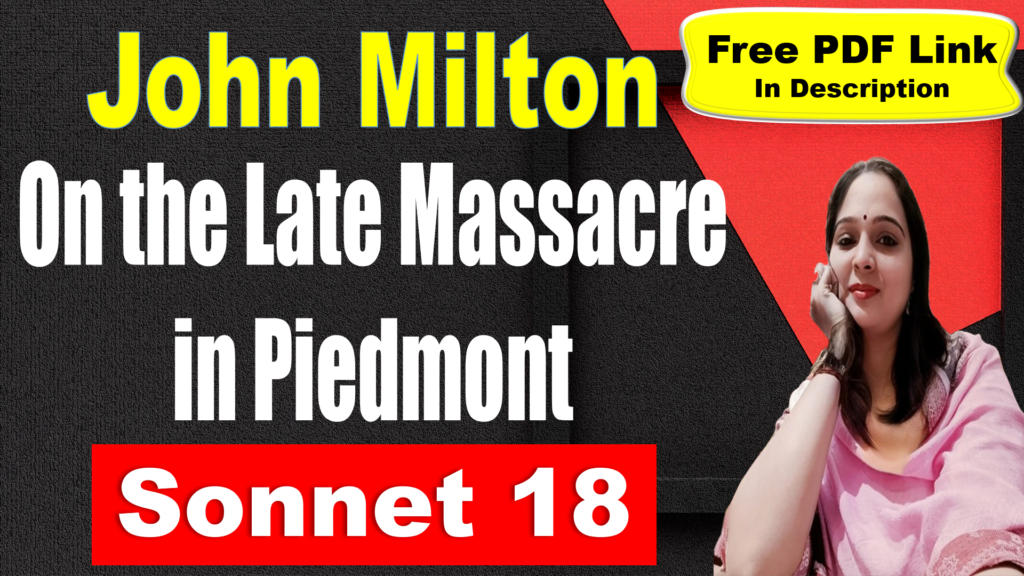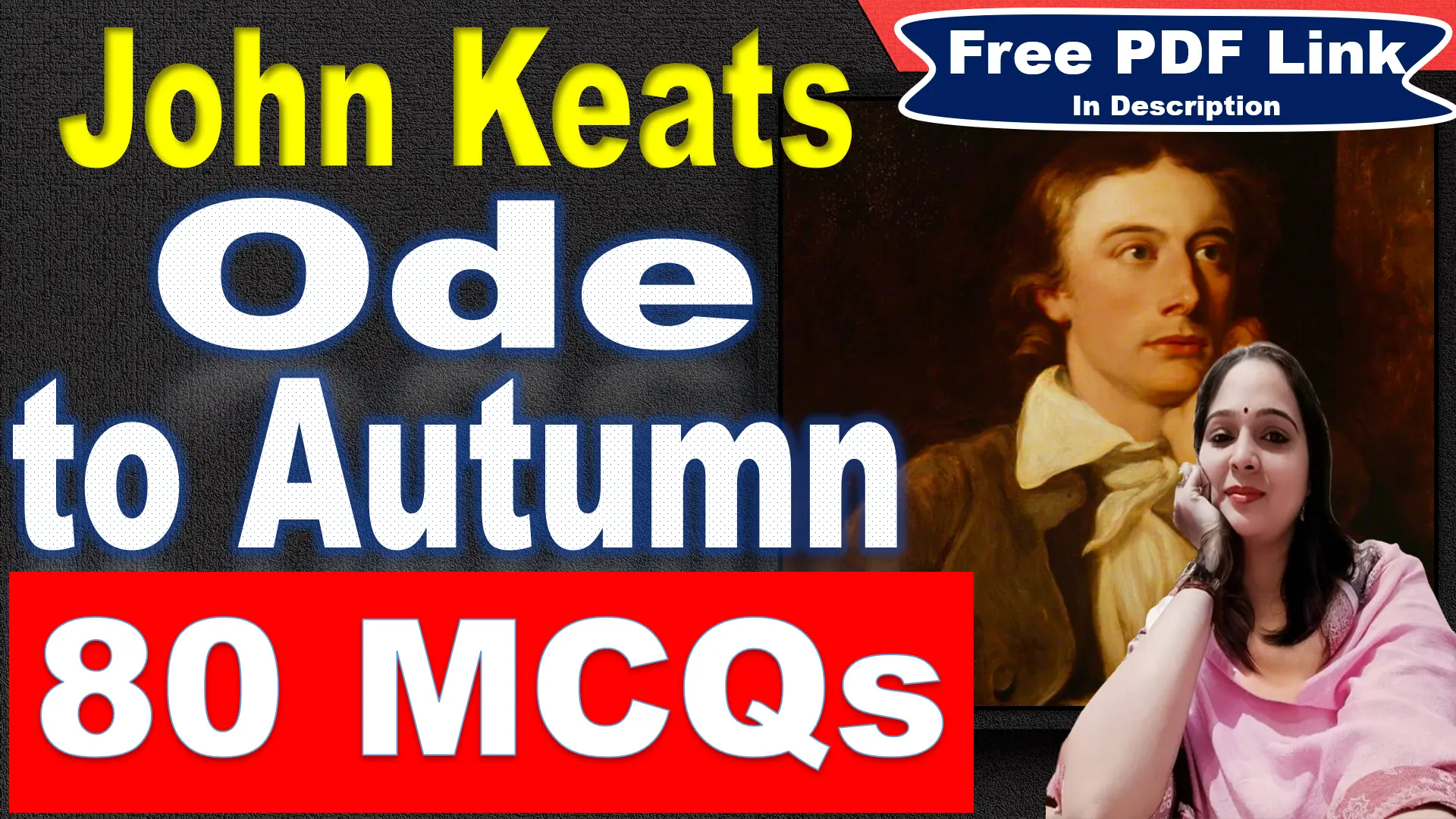
On the Late Massacre in Piedmont Questions and Answers
Very Short Answer Questions
Q: Who is the author of the poem?
A: John Milton.
Q: What event inspired the poem?
A: The 1655 massacre of the Waldensians in Piedmont.
Q: Who are the “slaughter’d saints” mentioned in the poem?
A: The Waldensians, a Protestant Christian sect.
Q: What does Milton ask God to do in the poem?
A: Avenge the massacre of the Waldensians.
Q: What literary form is the poem written in?
A: A Petrarchan sonnet.
Q: What does the “triple tyrant” refer to?
A: The Pope, symbolizing the Catholic Church.
Q: What is the rhyme scheme of the octave in the poem?
A: ABBAABBA.
Q: What imagery is used to describe the massacre?
A: Bones scattered on the Alpine mountains and mothers thrown down rocks with infants.
Q: How does Milton describe the Waldensians’ faith?
A: As keeping God’s truth “so pure of old.”
Q: What metaphor does Milton use for the growth of Protestantism?
A: “Martyr’d blood and ashes sow” over the fields.
Q: What biblical allusion is made in the line “fly the Babylonian woe”?
A: Babylon represents corruption and false worship, referring to the Catholic Church.
Q: How does Milton refer to the Catholic oppressors?
A: As “the bloody Piemontese.”
Q: What does Milton ask God not to forget?
A: The groans of the martyrs.
Q: What literary device is used in “slaughter’d saints”?
A: Alliteration.
Q: What is the tone of the poem?
A: Sorrowful and outraged, with a hopeful conclusion.
Q: What is Milton’s hope for the future of Protestantism?
A: That it will grow “a hundred-fold” from the martyrdom.
Q: What historical conflict does the poem reflect?
A: The religious conflict between Protestants and Catholics.
Q: What figure from Christian symbolism is referenced in “thy sheep”?
A: The faithful followers of God.
Q: How does the speaker describe the suffering of the Waldensians?
A: Their groans echo from the valleys to the heavens.
Q: What is the “ancient fold” in the poem?
A: The long-established community of true believers, symbolizing the Waldensians.
Short Answer Questions
Q: What historical event is Milton referring to in the poem, and why is it significant?
A: Milton refers to the 1655 massacre of the Waldensians, a Protestant Christian group living in the Piedmont region of northern Italy. Catholic forces brutally attacked and killed many Waldensians, including women and children. This event is significant as it reflects the religious persecution of Protestants by Catholics, and Milton, a devout Puritan, saw it as an example of religious tyranny that needed divine retribution.
Q: How does Milton portray the victims of the massacre in the poem?
A: Milton portrays the victims, the Waldensians, as innocent and faithful followers of God. He refers to them as “slaughter’d saints” and “thy sheep,” emphasizing their purity and righteousness. He contrasts their unwavering adherence to God’s truth with the violent cruelty of their Catholic oppressors, underscoring their martyrdom.
Q: What is the significance of the metaphor “martyr’d blood and ashes sow”?
A: The metaphor “martyr’d blood and ashes sow” suggests that the blood and remains of the murdered Waldensians will act as seeds that bring forth new life. Milton hopes that their sacrifice will lead to the growth of Protestantism, spreading their faith and inspiring future believers. This image conveys the idea that martyrdom can lead to spiritual renewal and resistance against oppression.
Q: Who does the “triple tyrant” refer to, and why is this figure important in the context of the poem?
A: The “triple tyrant” refers to the Pope, symbolized by the three-tiered papal crown (tiara). This figure is important because Milton, a Protestant, saw the Catholic Church and the Pope as symbols of religious tyranny and corruption. In the poem, the Pope represents the oppressive force behind the persecution of Protestants like the Waldensians.
Q: What is the overall tone of the poem, and how does it evolve?
A: The tone of the poem is initially one of sorrow, outrage, and grief as Milton describes the brutality of the massacre. However, it shifts towards hope and defiance in the final lines, where he expresses faith that the martyrs’ sacrifice will lead to the growth of true Protestant believers and the ultimate defeat of the Catholic Church’s influence.
Q: How does Milton use nature imagery to convey the suffering of the Waldensians?
A: Milton uses nature imagery to heighten the impact of the Waldensians’ suffering. He describes their bones as “scatter’d on the Alpine mountains cold,” evoking a bleak, desolate landscape that mirrors their tragic deaths. The moans of the victims are described as echoing from the “vales” to the “hills” and finally to Heaven, emphasizing the widespread and deeply felt nature of their pain.
Q: What role does religion play in the poem?
A: Religion is central to the poem, as it portrays the massacre of the Waldensians as a religious conflict between Protestantism and Catholicism. Milton invokes God’s justice and mercy, pleading for divine vengeance on behalf of the Protestant martyrs. The poem also reflects Milton’s Puritan beliefs, with an emphasis on the righteousness of the Waldensians’ faith and the hope for the spread of true Christianity.
Q: How does Milton contrast the Waldensians with their persecutors?
A: Milton contrasts the Waldensians’ purity and devotion to God with the cruelty and corruption of their persecutors, the Catholic forces. He portrays the Waldensians as “saints” and “sheep,” innocent and faithful followers of God. In contrast, the Catholic oppressors are depicted as brutal murderers, throwing mothers and infants down the rocks, showing no mercy.
Q: What is the significance of the phrase “fly the Babylonian woe”?
A: “Fly the Babylonian woe” is a biblical allusion to Babylon, which in Christian symbolism represents corruption, false worship, and moral decay. Milton uses it to refer to the Catholic Church, which he saw as spiritually corrupt. He expresses hope that future believers will avoid falling into the same spiritual errors and will remain true to God’s pure teachings.
Q: How does Milton use apostrophe in the poem, and what effect does it have?
A: Milton uses apostrophe at the very beginning of the poem by directly addressing God with “Avenge, O Lord.” This rhetorical device creates a powerful sense of urgency and emotion, as Milton calls upon God to intervene on behalf of the Waldensian martyrs. It highlights the personal and immediate nature of the plea, making the speaker’s call for divine justice feel more direct and intense.





